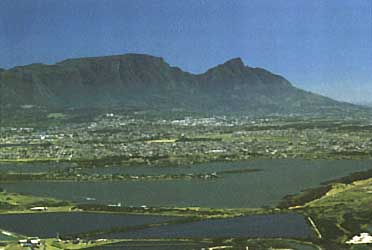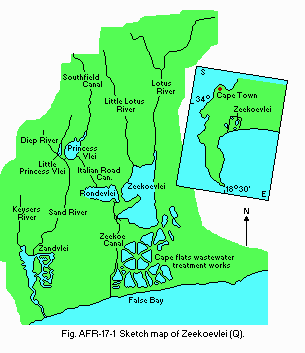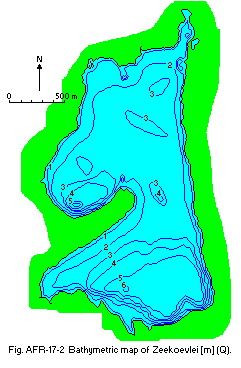ZEEKOEVLEI
An aerial view of the whole lake
Photo: W.R.Harding
A. LOCATION
- Western Cape Province, South Africa.
- 34:03S, 18:31E; 5.2 m above sea level.
B. DESCRIPTION
-
Zeekoevlei is the largest (256 ha) freshwater lake in South Africa, situated on the Cape Flats near Cape Town in the Western Cape Province. The Cape Flats are a low-lying, sandy region which was originally submerged beneath the sea and which separate the mountainous Cape Peninsula from the mainland. The prevailing climate is a Mediterranean, winter-rainfall type. Zeekoevlei is an important regional recreational venue. The lake is a shallow (mean depth 1.9 m), polymictic and hyper-eutrophic urban-impacted system, which has year-round non-limiting concentrations of nitrogen and phosphorus, with mean annual value of 3.6 and 0.55 mg l-1 respectively. Nutrient loading from the catchment occurs during the winter via the Big and Little Lotus Rivers. Of these, the Big Lotus River delivers in excess of 80% of the annual hydraulic flow, and non-point source catchment pollution results in mean annual concentrations of 2.2 mg l-1 N and 0.64 mg l-1 P in this influent water. The lake overflows only during the winter into a canal leading to the sea. Lake levels fluctuate by an average of 0.5 m between winter and summer.
The vlei is fringed by dense growth of the emergent aquatic macrophytes Typha capensis and The vlei contains no submerged macrophytes but is subject to isolated infestation by the floating water hyacinth, Eichhornia crassipes. Phytoplankton diversity is poor and the phytoplankton assemblage is dominated year round by the blue-green alga Microcystis. Growth of this alga completely masks the periodic characteristics of the sub-dominant taxa of Chlorophyta and Bacillariophyta. Typical mean annual chlorophyll a and Secchi disk transparencies are, respectively, 200 micro l-1 and 0.25 m. Maximal growth and water blooms of Microcystis are experienced during the spring.
The prolific growth of blue-green algae, coupled with restrictions of the natural hydraulic flushing of the lake as consequence of the construction of an outlet weir in 1948, have resulted in massive accumulations of organically rich sediments. These currently comprise 21% of the volume of the lake 1,100,000 m3, and are thought to play an integral role in the internal nutrient cycling and self-sustaining nature of the system during the dry summer season. Since 1990 Zeekoevlei has been the focus of a management investigation conducted by the Cape Town City Council to ascertain viable options for the lake's future rehabilitation (Q).
C. PHYSICAL DIMENSIONS (Q)
| Surface area [km2] | 3 |
| Volume [km3] | 0.005 |
| Maximum depth [m] | 5.2 |
| Mean depth [m] | 1.9 |
| Water level | Regulated |
| Normal range of annual water | |
| level fluctuation [m] | 0.5 |
| Length of shoreline [km] | 12.6 |
| Residence time [yr] | 0.2 |
| Catchment area [km2] | 80 |
D. PHYSIOGRAPHIC FEATURES
D1 GEOGRAPHICAL- Sketch map: Fig. AFR-17-01.
- Bathymetric map: Fig. AFR-17-02.
- Names of main islands: None.
- Number of outflowing rivers and channels (name): 1 (Zeekoe Canal).
- Climatic data at Cape Flats Wastewater Treatment Plant
| Jan | Feb | Mar | Apr | May | Jun | Jul | Aug | Sep | Oct | Nov | Dec | Ann. | |
|---|---|---|---|---|---|---|---|---|---|---|---|---|---|
| Mean temp. [deg C]*1 | 21.0 | 20.5 | 19.2 | 16.8 | 14.1 | 12.2 | 11.4 | 12.5 | 13.8 | 15.2 | 17.7 | 19.5 | 16.2 |
| Precipitation [mm]*2 | 4 | 7 | 18 | 69 | 61 | 111 | 124 | 85 | 35 | 17 | 7 | 9 | 547 |
- Number of hours of bright sunshine (1981-1990): 3,002 hr yr-1.
- Solar radiation: 17.84 MJ m-2 day-1.

Sketch map (Q).

Bathymetric map [m](Q).
- Water temperature [deg C]
| 1981-1990 | ||||||||||||
| Depth [m] | Jan | Feb | Mar | Apr | May | Jun | Jul | Aug | Sep | Oct | Nov | Dep |
| S* | 23.1 | 22.5 | 20.4 | 19.0 | 16.1 | 13.7 | 12.5 | 14.4 | 16.0 | 17.9 | 20.3 | 22.1 |
- Freezing period: None.
- Mixing type: Polymictic.
- Notes on water mixing and thermocline formation
The lake is mixed on an almost daily basis. Lowest wind speeds, with greatest incidence of calm periods, occur during the winter.
E. LAKE WATER QUALITY (Q)
E1 TRANSPARENCY [m]| Mean of 4 sampling stations, 1981-1990 | ||||||||||||
| Depth [m] | Jan | Feb | Mar | Apr | May | Jun | Jul | Aug | Sep | Oct | Nov | Dec |
|---|---|---|---|---|---|---|---|---|---|---|---|---|
| 0.24 | 0.24 | 0.24 | 0.27 | 0.27 | 0.29 | 0.29 | 0.31 | 0.24 | 0.23 | 0.25 | 0.24 | |
| Mean of 4 sampling stations, 1981-1990 | ||||||||||||
| Depth [m] | Jan | Feb | Mar | Apr | May | Jun | Jul | Aug | Sep | Oct | Nov | Dec |
| S* | 10.0 | 10.0 | 10.1 | 9.9 | 9.0 | 9.0 | 9.1 | 9.1 | 9.3 | 9.7 | 9.3 | 9.5 |
| Mean of 4 sampling stations, 1981-1990 | ||||||||||||
| Depth [m] | Jan | Feb | Mar | Apr | May | Jun | Jul | Aug | Sep | Oct | Nov | Dec |
|---|---|---|---|---|---|---|---|---|---|---|---|---|
| S* | 93.2 | 105.2 91.7 | 71.0 | 75.8 | 61.4 | 69.3 | 79.6 | 128.8 73.2 | 95.3 | 107.3 | ||
| Mean of 4 sampling stations, 1981-1990 | ||||||||||||
| Depth [m] | Jan | Feb | Mar | Apr | May | Jun | Jul | Aug | Sep | Oct | Nov | Dec |
|---|---|---|---|---|---|---|---|---|---|---|---|---|
| S* | 9.0 | 8.9 | 9.2 | 9.4 | 9.8 | 9.6 | 9.8 | 9.8 | 10.0 | 9.6 | 7.9 | 8.3 |
| Mean of 4 sampling stations, 1981-1990 | ||||||||||||
| Depth [m] | Jan | Feb | Mar | Apr | May | Jun | Jul | Aug | Sep | Oct | Nov | Dec |
|---|---|---|---|---|---|---|---|---|---|---|---|---|
| S* | 192 | 211 | 221 | 160 | 184 | 160 | 223 | 269 | 376 | 340 | 240 | 228 |
- Total-N [mg l-1]
| Mean of 4 sampling stations, 1981-1990 | ||||||||||||
| Depth [m] | Jan | Feb | Mar | Apr | May | Jun | Jul | Aug | Sep | Oct | Nov | Dec |
|---|---|---|---|---|---|---|---|---|---|---|---|---|
| S* | 7.2 | 7.4 | 5.8 | 5.4 | 5.0 | 4.4 | 4.7 | 4.5 | 4.9 | 4.3 | 5.8 | 5.7 |
- NH4-N [mg l-1]
| Depth [m] | Jan | Feb | Mar | Apr | May | Jun | Jul | Aug | Sep | Oct | Nov | Dec |
|---|---|---|---|---|---|---|---|---|---|---|---|---|
| S* | 0.15 | 0.16 | 0.15 | 0.14 | 0.14 | 0.11 | 0.23 | 0.25 | 0.12 | 0.10 | 0.10 | 0.11 |
- NO2-N + NO3-N [mg l-1]
| Mean of 4 sampling stations, 1981-1990 | ||||||||||||
| Depth [m] | Jan | Feb | Mar | Apr | May | Jun | Jul | Aug | Sep | Oct | Nov | Dec |
|---|---|---|---|---|---|---|---|---|---|---|---|---|
| S* | 0.06 | 0.07 | 0.03 | 0.06 | 0.06 | 0.05 | 0.77 | 1.10 | 0.84 | 0.22 | 0.12 | 0.15 |
- Total-P [mg l-1]
| Mean of 4 sampling stations, 1981-1990 | ||||||||||||
| Depth [m] | Jan | Feb | Mar | Apr | May | Jun | Jul | Aug | Sep | Oct | Nov | Dec |
|---|---|---|---|---|---|---|---|---|---|---|---|---|
| S* | 0.58 | 0.60 | 0.46 | 0.54 | 0.48 | 0.45 | 0.65 | 0.72 | 0.83 | 0.76 | 0.66 | 0.61 |
- Total soluble-P [mg l-1]
| Mean of 4 sampling stations, 1981-1990 | ||||||||||||
| Depth [m] | Jan | Feb | Mar | Apr | May | Jun | Jul | Aug | Sep | Oct | Nov | Dec |
|---|---|---|---|---|---|---|---|---|---|---|---|---|
| S* | .10 | .09 | .09 | .09 | .10 | .11 | .30 | .44 | .43 | .33 | .19 | .12 |
- Soluble reactive-P [mg l-1]
| Mean of 4 sampling stations, 1981-1990 | ||||||||||||
| Depth [m] | Jan | Feb | Mar | Apr | May | Jun | Jul | Aug | Sep | Oct | Nov | Dec |
|---|---|---|---|---|---|---|---|---|---|---|---|---|
| S* | .08 | .05 | .05 | .05 | .09 | .08 | .27 | .37 | .41 | .29 | .18 | .09 |
| Mean of 4 sampling stations, 1981-1990 | ||||||||||||
| Depth [m] | Jan | Feb | Mar | Apr | May | Jun | Jul | Aug | Sep | Oct | Nov | Dec |
|---|---|---|---|---|---|---|---|---|---|---|---|---|
| S* | 170 | 198 | 217 | 214 | 193 | 163 | 129 | 119 | 115 | 132 | 139 | 144 |
- The physico-chemical regime of Zeekoevlei has remained remarkably stable since monitoring began in 1981, and no trends, either increasing or decreasing, have been observed for the measured parameters.
F. BIOLOGICAL FEATURES (Q)
F1 FLORA- Emerged macrophytes: Typha capensis, Scirpus littoralis.
- Floating macrophytes: Eichhornia crassipes.
- Submerged macrophytes: None.
- Phytoplankton
Cyanophyta (Anabaena, Anabaenopsis, Aphanocapsa*, Chroococcus*, Microcystis*, Merismopedia*, Pseudanabaena, Raphidiopsis, Spirulina*), Chlorophyta (Actinastrum, Ankistrodesmus, Carteria, Chlamydomonas, Chlorella, Coelastrum, Crucigenia, Golenkinia*, Kirchnierella, Micratinium*, Oocystis*, Pediastrum*, Phacotus, Scenedesmus*, Selenastrum, Tetraedron*), Bacillariophyta (Chaetoceros, Cyclotella, Melosira, Navicula*, Nitzschia, Thalassiosira)(*denotes presence in 80% of samples).
- Zooplankton
Copepoda (Thermocyclops schuurmanae, Metadiaptomus prucelli), Cladocera (Daphnia longispina, D. pulex, Ceriodaphnia sp., Moina sp.), Rotifera (Brachionus sp., Keratella sp., Hexarthra sp., Polyarthra sp., Filinia sp., Asplanchna sp.). - Fish: Cyprinus carpio, Oreochromis mossambicus.
- Phytoplankton biomass [mg l-1]
| 1990-1991 | ||
| Dry weight | Organic material | |
|---|---|---|
| Minimum | 20.2 | 3.1 |
| Maximum | 90.4 | 58.6 |
| Mean | 48.2 | 34.7 |
G. SOCIO-ECONOMIC CONDITIONS (Q)
G1 LAND USE IN THE CATCHMENT AREA| Area [km2] | [%] | |
|---|---|---|
| Agricultural land | 20.8 | 26 |
| Residential area | ||
| - Commercial | 0.8 | 1 |
| - Industrial | 8 | 10 |
| - Residential | 26.4 | 33 |
| Others | ||
| - Open space | 24 | 30 |
| Total | 80 | 100 |
H. LAKE UTILIZATION (Q)
H1 LAKE UTILIZATION- Sightseeing and tourism, recreation (sport-fishing, yachting, power-boating and skiing).
I. DETERIORATION OF LAKE ENVIRONMENTS AND HAZARDS (Q)
I1 ENHANCED SILTATION- Extent of damage: Serious (accumulated algal sediments).
- Supplementary notes
The lake contains 1,100,000 m3 of accumulated algal sediments which are estimated to be increasing at a rate of 35,000 [m3 yr-1]. This sedimentation has been taking place since the construction of an outlet weir in 1948.
- Present status
No information (potential of algal toxins produced by Microcystis).
- Nuisance caused by eutrophication
Unusual algal bloom: Microcystis spp.
- Extent of damage: None.
J. WASTEWATER TREATMENTS (Q)
J1 GENERATION OF POLLUTANTS IN THE CATCHMENT AREA-
e) Severe pollution with little wastewater treatment.
- Sources of catchment pollution currently (1991) under investigation.
K. IMPROVEMENT WORKS IN THE LAKE (Q)
- None.
L. DEVELOPMENT PLANS (Q)
- Zeekoevlei is currently the focus of a working group investigation studying the ecology of the lake and the options available for its rehabilitation. Given the recreational venue status of Zeekoevlei, and the current socio/politico/economic conditions in South Africa, as well as the magnitude of Zeekoelvei problems (eutrophication), the justification of large expenditure for rehabilitation will be difficult.
M. LEGISLATIVE AND INSTITUTIONAL MEASURES FOR UPGRADING LAKE ENVIRONMENTS
M3 RESEARCH INSTITUTES ENGAGED IN THE LAKE ENVIRONMENT STUDIES- Scientific Services Branch, Cape Town City Council
N. SOURCES OF DATA
- Questionnaire filled by Dr. W. R. Harding, Senior Scientific Officer, City Engineer's Department, Cape Town City Council, South Africa, based on the following sources. l) Allanson, B. R., Hart, R. C., O'keeffee, J. H. & Robarts, R. D. (1990) Inland Waters of Southern Africa: An Ecological Perspective. Monographs Biology 64. 458 pp. Kluwer Academic Publishers, Dordrecht.
- Bickerton, I. B. (1982) Estuaries of the Cape, Part II. Synopses of Available Information on Individual Systems. Report 15, Zeekoe (CSW 5)(ed. Heydorn, A. E. F. & Grindley, J. R.), CSIR Research Report 414. 54 pp. Stellenbosch.
- Brummer, T. B. (1981) A development plan for the Zeekoevlei complex. Planning report submitted in partial fulfillment of the examination requirements for the Masters Degree in Town and Regional Planning in the Faculty of Arts, University of Stellenbosch. 72 pp.
- City of Cape Town (1990) Zeekoevlei User Assessment Survey. Town Planning Branch. 43 pp.
- Civil Engineering Contractor (1982) New dredging technique for Zeekoevlei. Civil Engineering Contractor, October: 61-65.
- Curtin, R., Aquadro, D., Hill, R. & Upsher, S. (1975) Management Proposals for Zeekoevlei. University of Cape Town, School of Envronmental Studies. Group Project, Various pagination.
- Davies, B. R. (1983) Report on Reed Removal at Zeekoevlei and Commentary on Aerial Photographs (1968 & 1980) showing the Development of Emergent and Submerged Vegetation in the Vlei. Report 6 to the Vleris Management Group of the Cape Town City Council. 7 pp.
- Dick, R. I. (1990) Zeekoevlei Sediments: Physical Characteristics and Interrelations with Overlying Water. Report to the Zeekoevlei Working Group of the Inland Waters Management Team. Cape Town City Council (unpublished).
- Fuggle, R. F. (1978) Surface Winds in Greater Cape Town. Volume 2. An Atlas of Wind Roses and Associated Tables. Survey conducted for the Cape Town City Council. 27 pp.
- Hall, D. J. (1990) The Biology and Control of Typha capensis in the Southwestern Cape Flats. Final report for the Cape Town City Council and the Divisional Council of the Cape. Report filed at the Town Planning Branch, Cape Town City Council. 123 pp.
- Hamman, K. C. D., Heard, H. E. & Thorne, S. C. (1977) Fish population structures as determined by seine and gill nets. Department of Nature and Environmental Conservation, Provincial Administration, Cape of Good Hope, Freshwaters: 6-23.
- Harding, W. R. (1990a) Bathymetry and Sediment Volume of Zookoevlei. Report to the Zeekoevlei Working Group of the Inland Waters Management Team. Report filed at the Scientific Services Branch, Cape Town City Council. 7 pp. (unpublished).
- --- (1990b) ComPosition of Sediments in Zeekoevlei. Cape Town City Council Report CB. 6/V2.2.2. 4 pp. (unpublished).
- --- (1990c) Interim Report on Primary Production in Zeekoevlei. Report to the Zeekoevlei Working Group of the Inland Waters Management Team. Report filed at the Scientific Service. Branch, Cape Town City Council. 6 pp. (unpublished).
- --- (1990d) Seepage into Zeekoevlei from the Cape Flats Tertiary Treatment Ponds. August 1990. Cape Town City Council Report CB. 6/V2.2.2. 4 pp. (unpublished).
- --- (1991) The ecology of some urban-impacted coastal vleis on the Cape Flats near Cape Town, with special reference to phytoplankton periodicity. Thesis submitted in fulfillment of the requirements for the degree M. Sc. (Zoology), University of Cape Town. 211 pp.
- Harrison, A. D. (1962) Hydrobiological studies on alkaline and acid still waters in the Western Cape Province. Trans. Roy. Soc. S. Afr., 36(4): 213-243.
- Hill, Kaplan & Scott, Consulting Engineers (1980) Report on Proposed Dredging and Reclamation: Zeekoevlei. NC/PJH/TD/EDM/7155. 12 pp. Cape Town.
- Howard-Williams, C. (1976) Proposals for an Ecological Investigation of Surface Waters in the Cape Peninsula. Report to the National Programme for Environmental Sciences and the Water Research Commission. 15 pp.
- Hutchinson, G. E., Pickford, G. E. & Schuurman, J. F. M. (1932) A contribution to the hydrobiology of pans and other inland waters of South Africa. Arch. Hydrobiol., 24: 1-154.
- King, P. B. (1973) Report on the Zeekoevlei Survey. Internal Report of the Scientific Service Branch, Cape Town City Council. 16 pp. (unpublished).
- Mepham, J. (1987) Wetlands of the south-western Cape. "Directory of African Wetlands and Shallow Waterbodies" (ed. Burgis and Symoens). Institut Fracais de Recherche Scientifique pour le Developpement en Cooperation, Travaux et Documents 211. 650 pp. Paris.
- Rudnick, J. G. (1986) Report on Ecological Conditions at Zeekoevlei during 1984. Report filed at the Scientific Service Branch, Cape Town City Council. 8 pp.
- Stephens, E. (1929) The Botanical Features of the South Western Cape Province. pp. 81-95. Specialty Press, Wynberg.
- Van Wyk, J. B. (1970) An Introduction of the Ecology of Zeekoevlei, Cape Peninsula. Report to the Department of Nature Conservation, Division of Inland Fisheries. 18 pp


